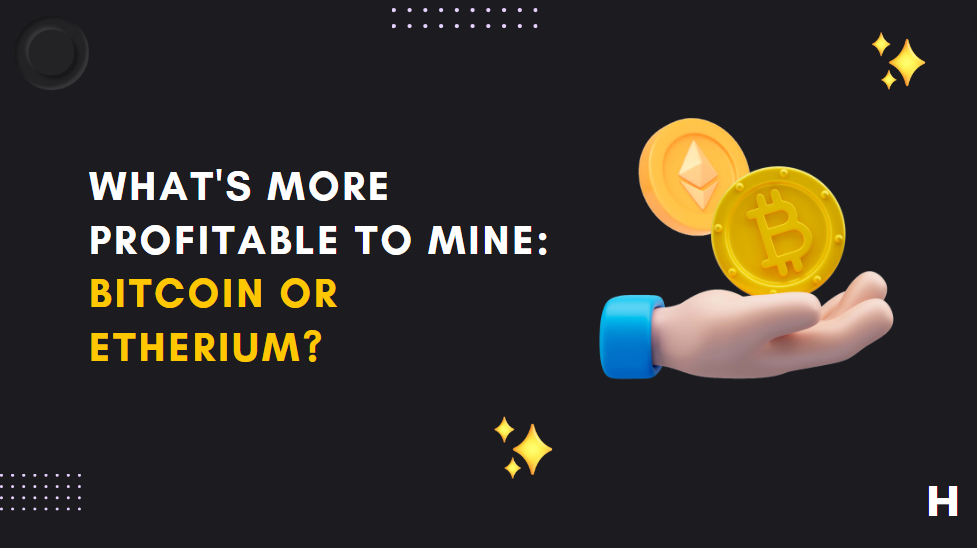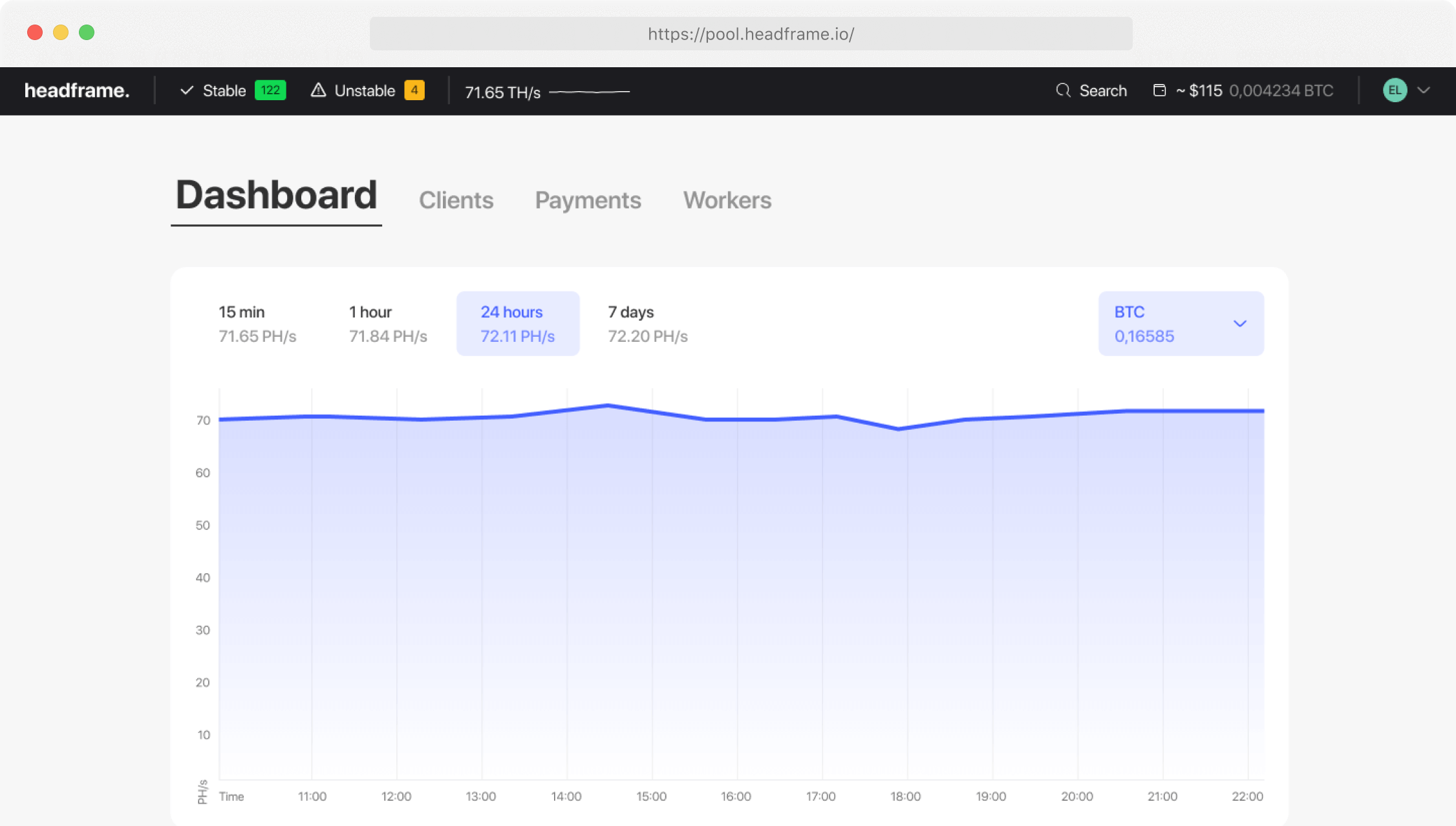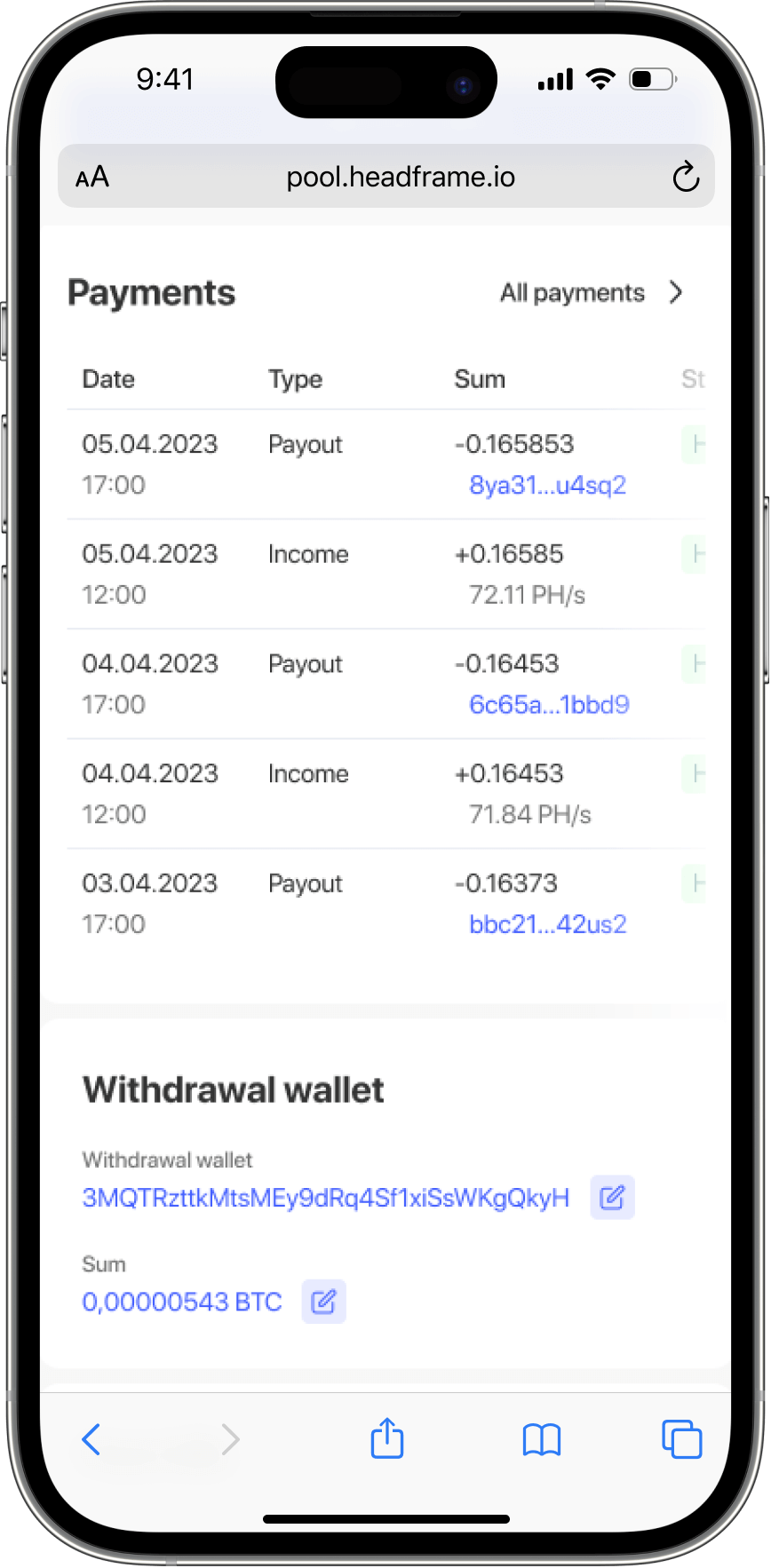
What is more profitable to mine: Bitcoin or Etherium?
Earn more money with Headframe
Join a mining pool and get the best profitability in mining. Already more than 10,000 miners trust Headframe.
- Which is more profitable to mine: Bitcoin or Etherium?
- Which is more profitable: Bitcoin or Etherium?
- Which is better, Bitcoin or Etherium in 2023?
- Which cryptocurrency is undervalued, Bitcoin or Etherium? An analysis in terms of profitability of mining.
- Conclusion: Which is better to mine – Bitcoin or Efirium?
What is more profitable to mine: Bitcoin or Etherium?
Bitcoin and Efirium are by far the two most famous cryptocurrencies on the market. Both have unique features and have gained significant recognition in the financial world, but the question remains: which one is more profitable to mine?
The profitability of mining Bitcoin or Etherium depends on various factors such as the cost of mining equipment, the cost and availability of electricity and the market price of the cryptocurrency. Therefore, there is no one-size-fits-all answer for all situations.
Bitcoin mining requires highly specialized equipment known as ASICs (Application-Specific Integrated Circuits), which can be expensive. In contrast, Efirium mining can be done on conventional Graphics Processing Units (GPUs), which cost less. In addition, Efirium’s upcoming transition to a Proof of Stake (PoS) mechanism could significantly reduce the profitability of mining.
In addition, power consumption is also worth considering. Bitcoin mining is widely criticized because of its negative environmental impact due to its high energy consumption. Efirium mining, while requiring significant energy consumption, still uses much less energy compared to Bitcoin.
Finally, the market price of cryptocurrencies plays an important role in determining profitability. At the time of my last update in September 2021, the value of Bitcoin was significantly higher than the value of Etherium. However, market prices fluctuate, and future direction can significantly affect the profitability of mining.
Which is more profitable, Bitcoin or Efirium?
Bitcoin
Bitcoin is the first cryptocurrency created in 2009 by an anonymous individual or group known as Satoshi Nakamoto. It operates on a technology called blockchain, which is a decentralized registry that records all transactions from any bitcoin user. Transactions are added to “blocks,” or linked pieces of code that make up a chain, and each transaction must be recorded in a block. Bitcoin is often referred to as digital gold because of its finite nature and value preservation function.
Etherium
Etherium is a blockchain-based open platform that allows developers to create and deploy smart contracts and decentralized applications (dApps). It was proposed in late 2013 and the development was raised through crowdfunding in 2014 and the network became active on July 30, 2015. The platform has its own cryptocurrency, Ether (ETH), which is used primarily for two purposes: as a digital currency similar to Bitcoin, and used within the Etherium network to run applications and even monetize work.
| COMPARISON CRITERIA | BITCOIN | EPHYRIUM |
| Purpose | Digital currency, means of accumulation, “digital gold” | Decentralized application platform |
| Year of creation | 2009 | 2015 |
| Creator | Satoshi Nakamoto (anonymous) | Vitalik Buterin and team |
| Coin Offerings | Limited to 21 million | No upper limit (as of 2021) |
| Algorithm | SHA-256 | Ethash |
| Consensus mechanism | Proof of Work (PoW) | Moving from proof of work (PoW) to proof of share (PoS) |
| Average block time | 10 minutes | 15 seconds |
| Smart contract option | No | Yes |
| Main applications | Digital currency, transfers, means of accumulation | Decentralized applications, ICO, DeFi |
It is important to note that Bitcoin and Etherium serve different purposes and therefore may attract different types of users. Bitcoin is primarily used as a currency and a means of storing value, while the primary use of Etherium is to power decentralized applications.
Choosing between Bitcoin and Efirium for mining depends on several factors, including:
- Cost of mining equipment: Bitcoin mining requires specialized ASIC (Application-Specific Integrated Circuit) equipment, which can be quite expensive. On the other hand, Efirium mining can be done on less expensive GPU (Graphics Processing Units) setups. Therefore, if you have a limited budget for mining equipment, Efirium may be a more viable option.
- Energy consumption: Bitcoin mining is known to consume a lot of electricity, which has raised environmental concerns. In contrast, Efirium mining tends to be less energy intensive, and with the upcoming transition to Efirium 2.0 and Proof of Stake (PoS), a significant reduction in energy consumption is expected.
- Block reward and transaction fees: Both Bitcoin and Efirium reward miners with a certain amount of cryptocurrency for each block mined. This per block reward, along with transaction fees, contributes to the profitability of mining. However, these rewards decrease over time, and miners should consider future reductions in rewards.
- Network Complexity: The complexity of both Bitcoin and Etherium mining increases as more miners join the network. Greater complexity means that more processing power is required to mine a block. The Bitcoin network is generally more complex (and therefore more resource-intensive) to mine than the Etherium network.
- Market value: The market value of Bitcoin and Efirium can affect the profitability of mining. Higher cryptocurrency prices can lead to higher mining profits. However, cryptocurrency prices are highly volatile and can change rapidly.
- Future Developments: Future changes to the Bitcoin or Etherium networks may affect the profitability of mining. For example, Efirium’s planned transition to Proof of Stake will eventually eliminate the ability to mine Efirium.
- Access to cheap electricity: Cryptocurrency mining is an energy-intensive process. The cost of electricity in your region can significantly affect the profitability of mining. In regions where electricity is expensive, the costs can exceed the rewards.
Depending on the factors mentioned above, both Bitcoin and Efirium can be profitable for mining.
If you have access to cheap electricity and can afford the high initial cost of ASIC hardware, Bitcoin may be more profitable due to its higher market value. However, Bitcoin mining has become very competitive and the chances of successfully mining a block as an individual miner are slim.
In contrast, lower barriers to entry and less competition may make Efirium more profitable for small scale miners. In addition, the upcoming transition of the Etherium network to Ethereum 2.0 (with PoS mechanism) may make it even more attractive, although mining will eventually be phased out.
Which is better, Bitcoin or Etherium in 2023?
Both Bitcoin and Efirium have performed strongly over the past years. Bitcoin has reached new all-time highs, reflecting its status as digital gold. Etherium, on the other hand, has made significant breakthroughs with the launch of the first phase of Ethereum 2.0 and the development of decentralized financial (DeFi) applications. From a mining perspective, Ether could have been a more favorable choice due to lower entry costs and increased demand for Ether caused by the DeFi boom. However, the significant rise in Bitcoin’s price has also made it an attractive option for those with the necessary resources to participate in Bitcoin mining.
Which cryptocurrency is undervalued, Bitcoin or Etherium? Analyzing it from a profitable mining perspective
Which of the two leading cryptocurrency players, Bitcoin or Efirium, is the most undervalued based on an analysis of their potential for mining? The choice between mining Bitcoin or Etherium depends largely on the mining method you choose to engage in – whether it’s CPU mining, GPU mining, ASIC mining, or cloud mining.
CPU mining
Although central processing unit (CPU) mining is the oldest type of mining, it is largely considered unprofitable today due to its low processing power compared to GPUs and ASICs. Bitcoin mining on CPU is almost impossible due to the sheer complexity of the network. Efirium mining on CPU, while theoretically possible, is unlikely to be profitable due to its low hash power and high power consumption.
GPU mining
Mining on a graphics processing unit (GPU) is significantly more efficient than mining on a CPU. Although Bitcoin mining on GPUs is less profitable due to the high network complexity and lower hash rate of GPUs compared to ASICs, Efirium mining on GPUs can be profitable, especially when participating in a mining pool. However, as Etherium moves to Ethereum 2.0, GPU mining may become obsolete.
ASIC mining
ASIC (Application-Specific Integrated Circuit) provides the highest hash rate of any type of mining and is the most profitable way to mine Bitcoin. Etherium was designed to be ASIC resistant to prevent network centralization, but with the upcoming upgrade to Etherium 2.0, ASIC mining may become obsolete.
Cloud mining
Cloud mining allows you to rent mining equipment in a remote data center and share the rewards of mining. This can be lucrative if the price of the cryptocurrency mined exceeds the value of the mining contract, but has its own risks, including fraud and mismanagement.
Thus, Efirium mining seems like a more affordable entry point for individuals or small groups, especially with GPU mining. However, Bitcoin mining can be more lucrative for large-scale operations or for those investing in ASICs. All of this emphasizes the fact that both Bitcoin and Efirium have their advantages and disadvantages, and the choice between the two depends largely on the specific conditions and resources of each individual miner.
| TYPE OF MAINING | BITCOIN | EPHYRIUM |
| Mining on CPU (Central Processing Unit) | Practically impossible due to the high complexity of the network | Theoretically possible, but unlikely to be profitable due to low hash power and high power consumption |
| Mining on GPU (Graphics Processing Unit) | Low profitability due to high network complexity and low hash rate compared to ASICs | Can be lucrative, especially when participating in a mining pool. However, the transition to Ethereum 2.0 may make GPU mining obsolete |
| Mining on ASIC (Specialized Integrated Circuit) | The most profitable way to mine Bitcoin | ASIC miners for Ethereum exist, but their advantage over GPUs is less pronounced. The transition to Ethereum 2.0 may eventually make ASIC and GPU mining obsolete |
| Cloud mining | Can be profitable if the price of the mined cryptocurrency exceeds the value of the mining contract | Can be profitable if the price of the mined cryptocurrency exceeds the value of the mining contract |
*The table gives a general estimate of profitability, but specific results may vary depending on a variety of factors, including electricity costs, cryptocurrency price, and equipment costs.
Conclusion: Which is better to mine – Bitcoin or Efirium?
The question of what is better to mine, Bitcoin or Efirium, does not have a universal answer. The choice between mining Bitcoin and Efirium comes down to a few factors that affect profitability:
- Type of mining: Depending on the type of mining you choose – CPU, GPU, ASIC or cloud mining – your profitability may vary. Bitcoin mining is nearly impossible with CPUs and GPUs, but can be very profitable with ASICs and large-scale operations. On the other hand, Efirium mining can still be profitable using GPUs, especially for individuals or small groups.
- Costs: This includes both the initial investment in mining equipment and ongoing costs such as electricity. In regions with cheap electricity, mining both Bitcoin and Etherium can be more profitable.
- Market Value: The current and future market value of the cryptocurrency you are mining significantly affects profitability. However, it is difficult to predict future cryptocurrency prices due to their volatile nature.
- Future network changes: Changes to the Bitcoin or Efirium networks can affect the profitability of mining. Efirium’s planned transition to Proof of Stake will eventually eliminate the ability to mine Efirium.
- Mining Complexity: As more miners join the network, the complexity of mining increases, making it harder to mine new blocks. At this point, Bitcoin’s network is generally more complex (and therefore requires more resources) to mine than Efirium’s network.
With all of these factors in mind, it seems that Efirium may offer a more affordable entry point for individuals or small groups, especially through GPU mining. However, for those who can invest in ASICs or run large-scale operations, Bitcoin mining can potentially be more lucrative.
Nevertheless, it is crucial for prospective miners to do thorough research and consider their specific circumstances before deciding whether Bitcoin or Efirium is more lucrative to mine. Like any investment, mining involves risk, and it is important to consider that the profitability of mining can fluctuate due to market price volatility and the increasing complexity of mining.


